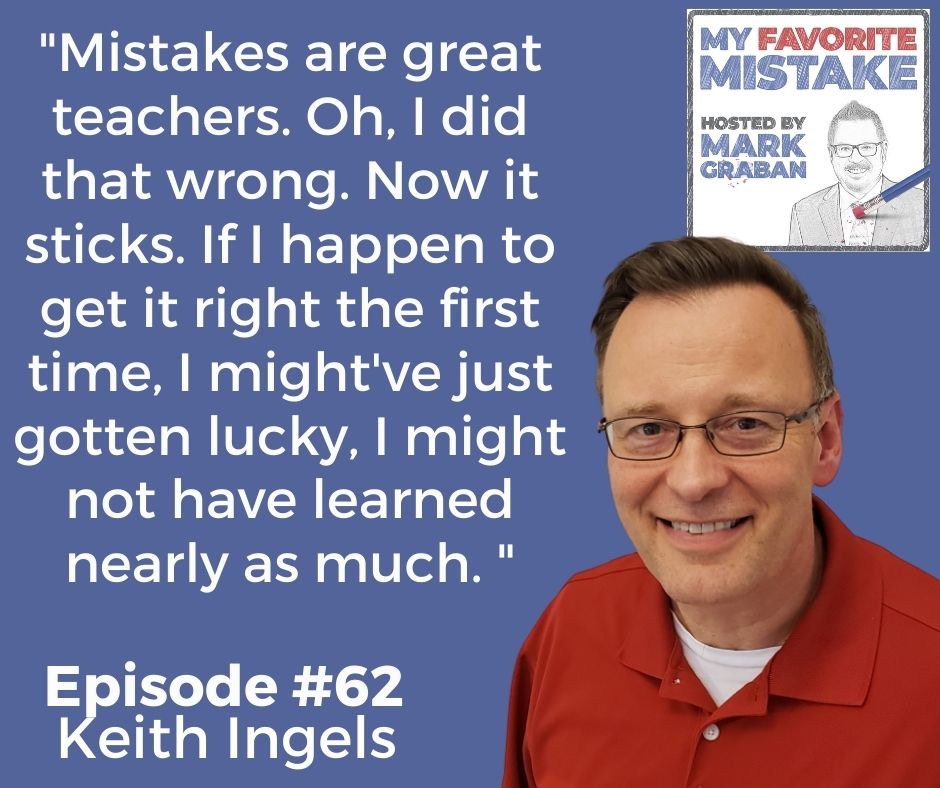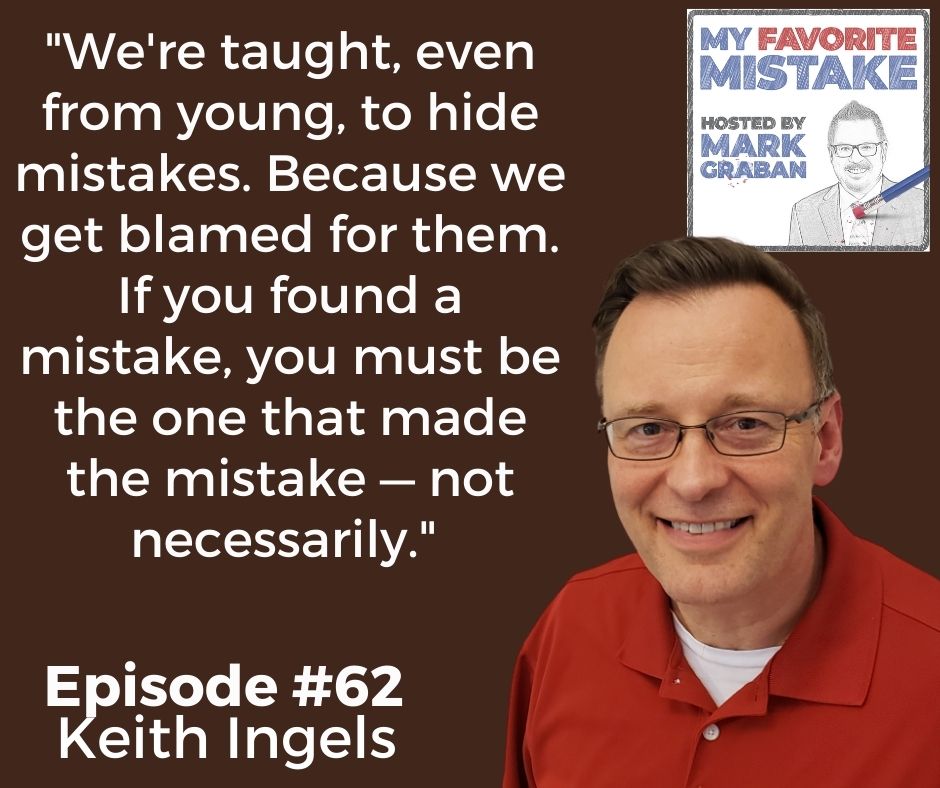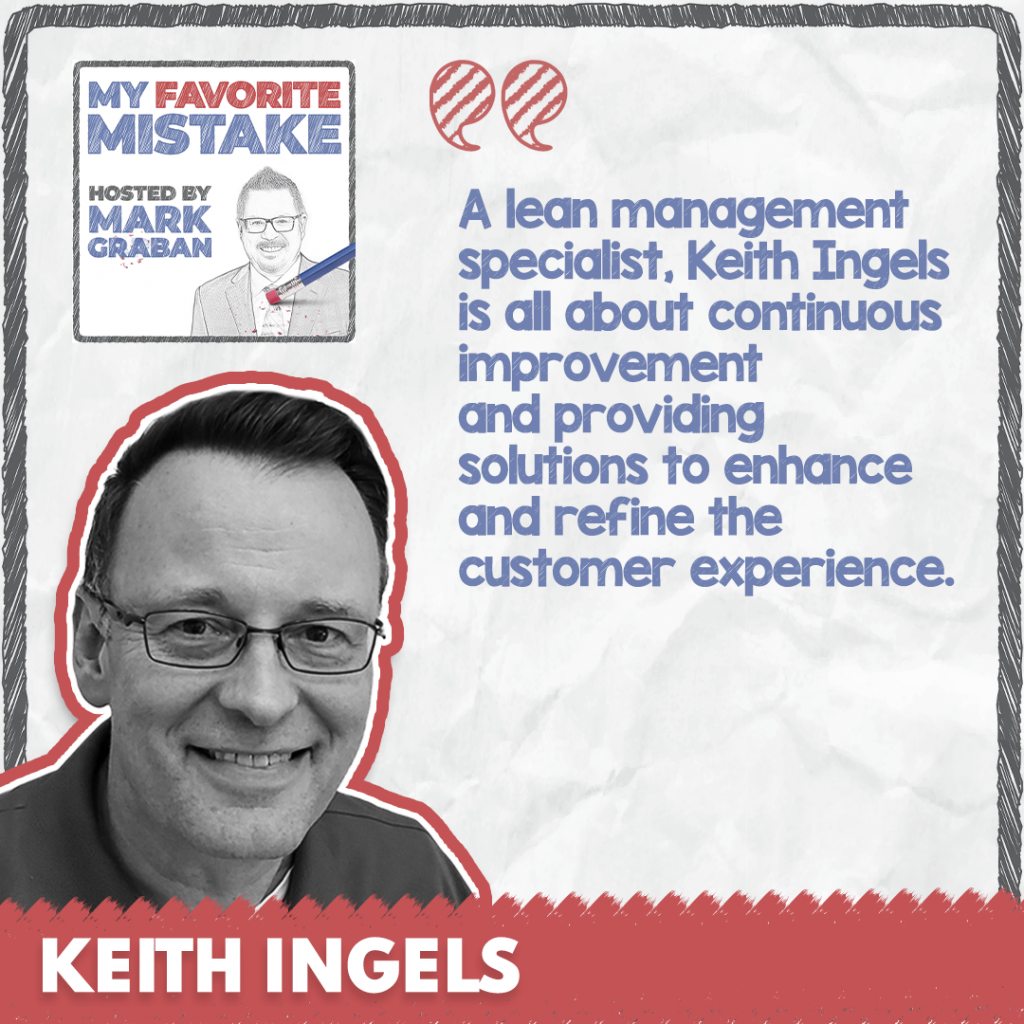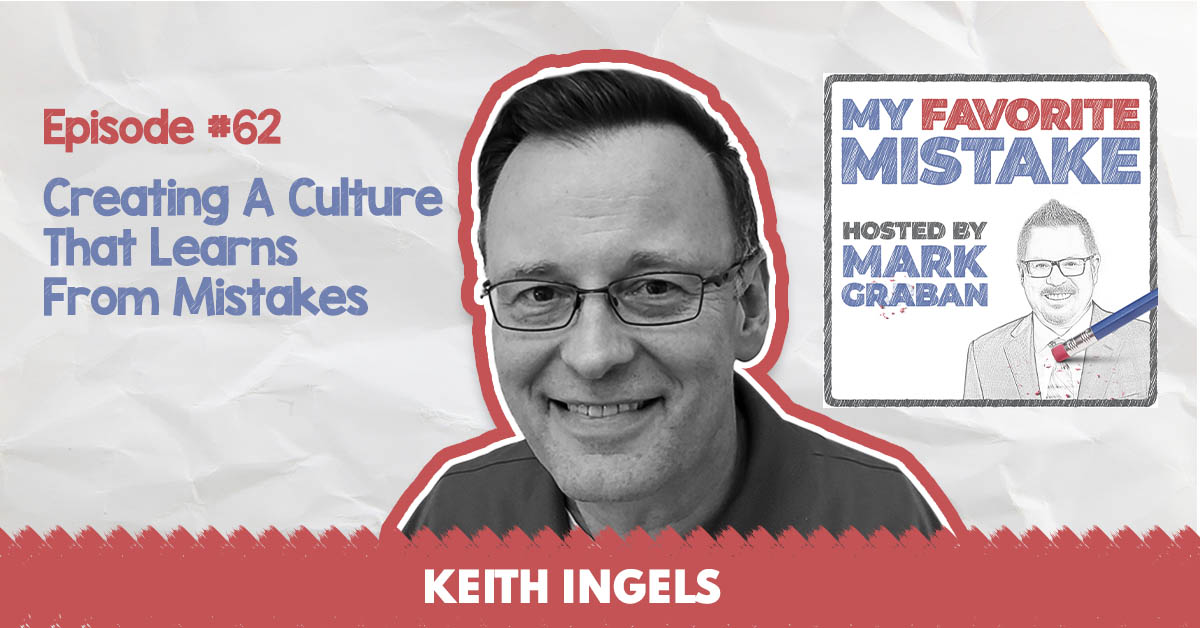Listen:
Check out all episodes on the My Favorite Mistake main page.
My guest for Episode #62 is Keith Ingels, the “TPS Manager” (Toyota Production System Manager) at The Raymond Corporation, a Toyota Industries Company. Learn more about the “Raymond Lean Management System, which is based on TPS. We had a longer conversation about this on my Lean podcast series, if you want to check that out.
In today's episode, Keith and host Mark Graban talk about one of his “favorite mistakes,” misunderstanding what the common Lean /TPS method called 5S really was really about. How did he make the “mistake of bad assumption” in the course of that work? Why was that mistake repeated, and how could it have been avoided? Why was it a mistake to blame people for being messy?
One key lesson was about how can we help others “discover the need” for an improvement or a method instead of “forcing” them to do it?
Keith also discusses how they work to create a culture where it's OK to talk about mistakes, so we can learn about them — that's the key theme of this entire podcast series!
The Raymond Corporation also offers a free “quick tips” series on improvement, if you want to check that out.
Watch the Full Episode:
Quotes:


!["In some areas of the business, we refer to [mistakes] as treasures, just to get people to embrace finding them and bringing them out. Because, ultimately, we can't fix a problem that we cannot find."](https://www.markgraban.com/wp-content/uploads/2021/04/Keith-Ingels-My-Favorite-Mistake-4.jpg)
Subscribe, Follow, Support, Rate, and Review!
Please follow, rate, and review via Apple Podcasts or Podchaser or your favorite app — that helps others find this content and you'll be sure to get future episodes as they are released weekly. You can also become a financial supporter of the show through Anchor.fm.
You can now sign up to get new episodes via email, to make sure you don't miss an episode.
This podcast is part of the Lean Communicators network.

Other Ways to Subscribe or Follow — Apps & Email
Creating A Culture That Learns From Mistakes: Keith Ingels

In this episode, our guest is Keith Ingels. He is with a company called Raymond Corporation. He is a TPS Manager. For those who are aficionados of the movie Office Space, this is not that TPS. It means Toyota Production System. We'll have a chance to explore some of that. First off, Keith, thank you for being a guest here on the show.
Thank you, Mark. I appreciate the opportunity to be here.
Before we talk about your favorite mistake or mistakes in corporate culture, it might be helpful for the audience for you to give a little bit of introduction about Raymond, where you fit within the corporate family tree and why Toyota Production System is relevant to that.
Toyota has ownership of Raymond Corporation. Raymond has been around for many years and has had a big impact on material handling. They patented the pallet. They put a patent on the first narrow aisle equipment for narrow space warehousing. Many years ago, Toyota acquired Raymond. Raymond was very fertile soil for innovation and quality.
In blending with Toyota's thinking of the Toyota Production System, this is a way to speed up that continuous improvement process. Raymond was fertile soil for that thinking and that culture to take root. We took the Toyota Production System. We adopted our factory. Later, we've been working throughout our network of distribution, dealers and solution and support centers to embrace that same philosophy. It's yielded a lot of success for us.
We’ve got a longer conversation that Keith and I did in a show series of mine called Lean Blog Interviews. It is where we take a deep dive into the Toyota Production System, the work that they're doing at Raymond and how that's all transferrable to other settings. That was a good conversation that we had about that. Thinking back to your career and the work you've done, what is your favorite mistake?
One of the big ones I made inspired me from our last conversation. I tell this story a lot. I was working at Toyota at the time. I got to make this mistake a couple of times but the first time and the biggest was I had some continuous improvement knowledge but I'd never been exposed to 5S. 5S is a system that a lot of people hear about. I got taught 5S for the first time. I was very excited about it. I got it as Sift, Sort Sweep, Standardize and Sustain. There are different ways to teach it.
I got excited about the instruction and thought, “This is great. This is housekeeping an organization. We're going to clean the place up. It makes sense.” I went back to our shop service team. We have large shops in our facilities where we bring in forklifts for service, big overhauls and mass work or heavy work. Our shop was a mess. It was not clean. I was like, “Let's go apply 5S in the shop.” We taught 5S to the crew. They go, “We’re going to be cleaning this place up. It will be great.”
We got together. We took a week. At the end of every day for several hours, we scrubbed and cleaned. We have four scrubbers with elbow grease and cleaners. We cleaned it. We thought we got rid of a lot of stuff because we kept emptying trash cans. We thought, “This is great.” This might surprise you. Since we all worked in the shop together as a team, we all knew where everything went and belonged. We didn't need any visual support. We were good. We didn't put any visuals in place because we all knew where everything went.
There was no need to mark, for example, where tools or equipment would go as people might often do.
We didn't need to do that. It wasn't necessary. It was a waste of time and effort. We had this well in hand. That shop was clean and we were happy. Over the next few weeks, there were a couple of things we started to learn. One, we weren't the only people going into the shop. There were parts people coming in, field tourist people or salespeople. There were all kinds of people coming to the shop. They didn't know where anything went. They kept putting stuff, borrowing stuff and moving it. They put it in the wrong place. That was frustrating.
The other thing we realized was we were busy. A lot of times, it was good. I would walk out through the shop and talk to the team. I’m like, “We're starting to get messy again.” I got this response, “We're busy today but we're going to catch up tomorrow.” That sounded reasonable to me. For about a month, it sounded reasonable but we were two months past. I go walk into the shop, look around and I can't tell if we had cleaned anything.
I was like, “This is not good. We're trying to deliver good customer service here and we can't find tools and things. We got to fix this. Let's get back together as a team. What do we have to do?” They were like, “Do you know when we didn't mark anything or put any visual support?” I was like, “Yeah.” I remember them talking about home location. We did a smart thing, which was painter's tape and marker. We started putting positions in. We didn't get too fancy at first because we didn't know what we were doing. We had a learning curve. We started marking things.
The first thing that I observed we learned as a team was if people borrowed something that wasn't familiar with the shop and they know where it goes, they'll put it back where they see it goes. I realized people were what we call disrespecting the area. They weren't disrespecting the area because they were trying to mess up our workspace. They were disrespecting it inadvertently because they didn't know where anything went and we hadn't shown them. We did that. We also started putting more cleaning equipment around. We also added a 5S Friday to clean up. I know that's not the way to do, 5S but to build the habit, we would take an extra half-hour plan every Friday, for sure. We were only getting, at most, a week behind before we started to make an impact or return.
We also did another smart thing that was planned. It had a bigger impact than I realized at the time. We had a service technician training roster that showed all the experience and special training every service tech had. All techs are trained in the core equipment but their specialty equipment is odd stuff that we don't work on all the time. Not everybody's trained on it. We had that visual up. If you needed to know who is trained on something, you can go out and look at that. You know whom to ask for help or support. That turned out pretty well.
We started sustaining and then realizing, “This is going in the right direction.” That was pretty good learning. I was like, “This 5S stuff may be a little more than housekeeping.” It started to dawn on me. Let’s move the clock ahead a few years. I’m in the Raymond organization. I go into a shop facility and say, “Go ahead and walk our shop. Give us some feedback. Tell us what you think.” I walked through the shop looking around. I'm going, “This looks like my shop when I was at Toyota. It's not great. There's stuff everywhere. It's chaos.”
I talked to the management team and said, “How would you like to clean this area?” It turns out that was a hot button for some of the managers. Some were saying, “Our field techs are bad about coming in. It's a mess. They leave it a mess.” I had enough experience, at this point at least, to say, “We haven't set a standard or expectation. Think about this. They're coming into a messy shop. They do the work and leave it a mess because that's what they came into. Nothing was telling them that that was not okay. If you walk in sight unseen, it's a mess and that's okay.”
The crew said, “That all makes sense.” It was a big group. They decide, “Let's get everybody together for a week.” I was like, “This sounds familiar. It's like déjà vu.” They were like, “We're going to clean up the whole shop.” I'm raising my hand like, “I don't think that's going to work.” They were like, “It'll be great.” I was like, “I don't think so. It's not my experience.” Sure enough, we clean up the whole shop. Guess what we didn't do again? There were no visuals. They were like, “Where do the tools go?” Everybody cleaned it up so it's good.
We all know the mindset of, “We all know. We all work here.”
We cleaned it up and sure enough, it was the same stuff all over. We don't have visual support. People are going through the shop. They're messing up and sliding them back again. At least this time, I could coach and start saying, “We’re going to fix small areas, make visuals and start to turn it around.” When the techs got involved, we learned their workspaces were important to them. They needed to lay it out themselves. They needed some autonomy and visual support.

At first, there was a lot of pushback because they would say, “I don't need visuals. I know where my tool goes.” I’m like, “Do you ever bring that tool out?” They’re like, “Sure.” I’m like, “Do people try to bring it back?” They’re like, “Yeah, but they always put it back in the wrong space.” I’m like, “We can help you fix that.” They’re like, “Do we have to mark my tools?” I’m like, “Yeah. It could be something simple like cardboard outlines. We’ll do something simple, quick, not expensive and time-consuming.” We started doing that. Little by little, we started weaving in this concept of visuals and sustainment. As we keep doing this, it gets better and starts to catch in the shop. People realized they liked being able to walk over and find what they need. They liked having a clean shop.
The last piece of my learning in this discussion came into focus for me. I often talk about this process. It's like looking through a set of binoculars and you focus it. The picture is blurry but it gets sharper. This was a moment where my vision sharpened. At this point, the shop's pretty clean. It's got visual support. We had a couple of new techs come in. All the tools and supplies they need are visualized.
They come in with a technical background but they had no specific Raymond training and skills. We’re like, “Go fix a forklift.” They’re like, “I don't know how yet. I haven't been trained yet.” This is where that concept we talked about last time, which is workplace readiness. We gravitate towards getting the tools and supplies in the area. This is the first time it dawns on me. Workplace readiness means the knowledge, skills and experience of the people.
No matter how great I set those tools up and I've got all those supplies ready, if I put someone in that doesn't know what to do and how to use those things, they cannot get that repair completed. I'm like, “This is fascinating.” It occurred to me for the first time. 5S is not housekeeping. It starts as housekeeping but it's about workplace readiness.
It may look like housekeeping.
You get that clean area and those before and after. It’s like, “It's pretty disorganized. Why don't we have it clean and organized?” It's about executing for the customer a better experience. We're trying to get to deliver things on time defect-free. The way we do that is to have the tools and supplies but also the knowledge, skills and experience of our people. That was the first time that it dawned on me that this was the foundation of the system.
When you talk about, “This is a system that comes together,” the foundation of that system is a ready workplace. The visuals and cleaner organization are part of it but the bigger piece is your people. They need to know why it's clean and organized. Can you tell them to clean up? I get a lot of pushback on that. They don't want to clean up but once they realize cleaning up helps make their work easier, that's the magic of the fifth S, the Sustained piece.
If people know this stuff works, they'll do it. It becomes cultural. When it's cultural, it's sustained. Until it's cultural, you're going to fight with it. I spent a lot of time and effort cleaning up shops. If anybody has a big area and they say, “I'm going to start my continuous improvement. I'm going to do a big cleanup,” don't do that. You can. If it's good for learning, then it's valuable in time but I can tell you from experience, it's not going to work.

Thank you for that. It’s a rich story. There's a lot to unpack. I took some notes there. There are different types of mistakes. One, as you summarize at the end, there's a mistake of misunderstanding what a business concept is about. In this case, it's about the 5S as part of the Toyota Production System. It could be other new things that are adopted in a workplace. Sometimes, we misunderstand and then we learn through experience. Here’s my follow-up question for you. You were talking about repeating that mistake and people learning that there is value in marking where tools go. Is that a “mistake?” Is that a learning that each and every team had to through on its own for them to embrace this? You almost framed it as a mistake. Was it a mistake or is that necessary learning?
I continue my learning journey as well in this all the time. As you and I both know, it's never-ending. One of the things I've found is one day, I found myself coaching. We coach on taking waste out of the process. One day, I was watching another trainer. We had an exercise in front of some people. The trainer was giving the answer to the people. I stopped the trainer and said, “You're giving them the answer.” He said, “They're not getting it.” It never crossed my mind that I'd realized this. I said, “If the struggle adds value, it's not waste.” We call waste non-value add. If the struggle adds value in the form of, “I've learned,” by definition, it's not a waste.
You bring up a great point. This is like learning to ride a bicycle. I can show you PowerPoints. I can ride the bicycle around for somebody else but until they get on it their selves, they don't get it. A lot of the system is the same way in my experience. I can tell people, “Having a clean and organized place will make your easier.” They’re like, “That makes sense.” I don’t get pushed back on that but I get pushed back on the effort.
The other thing is they'll go bananas with visuals. They'll go from no visuals to visualizing everything. They outline where the stapler on your desk is. If you're the only one using that stapler, you don't need that. I know where that goes. If you open your drawer and there are pens in a little slot laying there, I maybe don't need to know that's the pen slot because it's rather obvious. There is always learning with it. Workplace readiness is what we're trying to get to.
Maybe we can talk more generally about what I heard you describe as the mistake of blaming individuals for what might be a systemic problem. We say, “They're being messy and disrespectful.” I think of a parking lot example. When there are lines painted, generally speaking, people will park between the lines. If we had a parking lot that was unpainted, it might be easy to come out and be judgmental of, “Look at that. That driver is a jerk. They parked too far away from the other cars.” Without lines, how would they know?
The parking lot is a great example because it's one of those standards we see. Haven’t we all complained about that person that gets over the line? We’re like, “I could have parked there if they moved over a few engines.” It becomes that and hopefully, positive peer pressure. You're right. Another piece of that culture is allowing people to learn from mistakes. That's sometimes difficult.
It's like that trainer that was like, “I've got to give them the answer. They're not getting it.” They’ve got to work through it. If it doesn't come to a conclusion, it won't stay. If they do it wrong, they're going to remember it. I agree that mistakes are great teachers. It’s like, “I did that wrong. Now, it sticks.” If I happen to get it right the first time, I might've gotten lucky. I might not have learned nearly as much.
[bctt tweet=”Mistakes are great teachers. “Oh, I did that wrong.” Now it sticks. If I happen to get it right the first time, I might’ve just gotten lucky. I might not have learned nearly as much.” via=”no”]
One of the themes of the show here in general is we all make mistakes. Hopefully, we're learning from them. That requires, at some point, a cycle of personal reflection, a coach or somebody prompting us to think about how things went and whether they go the way we expected. If not, what do we learn from that? How do we adjust?
Can you talk a little bit more about that culture either at Toyota or within Raymond Corporation? As part of the Toyota family tree, how do you create a culture where it's okay to talk openly about mistakes, reflect and make sure that we're learning from them instead of hiding and covering up the mistakes so it ends up getting repeated?
To start, the first I'll say is it's a lot of work but it's a lot of work that's well worth it. I've had this conversation with a lot of trainers and coaches over the years. My best guess is we're taught, even from young, to hide mistakes. We get blamed for them. If you found a mistake, they’re like, “You must be the one that made the mistake.” That’s not necessary. We have this process of unlearning. We teach that mistakes are positive.
[bctt tweet=”We’re taught, even from a young age, to hide mistakes because we get blamed for them. If you find a mistake, you must be the one who made it—but not necessarily.” via=”no”]
Sometimes, in some areas of the business, we refer to them as treasures to get people to embrace finding them and bringing them out. Ultimately, we can't fix a problem that we cannot find. If we can't find that problem, we sure can't fix it. As well as that sounds obvious, it's not because people don't want to bring it to attention. They had a bad experience bringing problems to light. You have to reinforce and have a lot of buy-in from your leadership that mistakes are okay and that it is a positive thing.
[bctt tweet=”In some areas of the business, we refer to mistakes as treasures just to get people to embrace finding them and bringing them out. Because ultimately, we cannot fix a problem that we cannot find.” via=”no”]
In the service business, as an example, we focus on what's broken. It tends to be a negative focus because that's our value add. We fix the broken. We're always looking at the broken. It can give a negative bent. These concepts apply to any kind of business. Let's talk about workplace readiness. It doesn't matter what you do. If you're a dentist or a chef, it doesn't matter what your customer needs. Having that workplace ready is going to help you.
The details and particulars of a workplace including the knowledge, skills and experience of the person are going to change from service and product but the general concept is important. The culture becomes the driving piece. It's important to serve my customer and be like, “How do I do that better?” I’m starting to remove mistakes and problems from that customer experience. It takes a lot of work and effort. Companies that learn to do it well skyrocket past competitors. Is it worth it? It is.

It seems like there are different categories for some of these mistakes. There are mistakes of understanding or misunderstanding. There are mistakes of bad assumptions. It’s the assumption, “We all know what our tools and supplies are and where they go.” That was discovered to be a bad assumption and there was learning and improvement that came from it.
The other thing that stands out, to try to summarize and repeat back to what you were saying, is this idea of working through it on their own. I would agree that maybe that's not a mistake. That's a necessary process. It's the difference between giving a fish versus teaching somebody how to fish or learning to fish, not just by looking at a PowerPoint slide or a video on fishing. Working through it on their own may very well be necessary or a value add. It makes me think of the Toyota-ism of going slow to go fast. Let me make a variation. Sometimes, going slower means you have better sustainment. In the long run, you're more effective. Is that fair to say?
It is. There are a lot of things that go into that. When you're rushed to do a quick repair of something, a lot of times, you're attacking a symptom and not the root cause. You'll put a bandage or something and you're like, “That's good enough.” You haven't considered the problem deeply enough. It turns out, you didn't resolve it. A problem well-defined is a problem half solved. We tend to work at a quick pace. It becomes counterintuitive that slowing down is better.
When we teach the plan-do-check-act, more planning helps reduce the overall time because your execution is smoother. Your check, act or adjustment time is shorter. Planning doesn't always feel like doing. We want to rush in to do and we don't have a good plan yet. It takes a deliberate effort to be able to engage that culture and thinking. It takes some practice. You got to build it into a habit.
To wrap up, this is a little bit key. You talk about helping others. In the Raymond Corporation, you and others there are helping others by making resources available. There are free resources that others can learn from. Tell us a little bit about that. Can you talk about some of the things that you have that others can go and learn from?
For a lot of our material and continuous improvement, we do white papers. We do various published works that we put out there and are available. A lot of this comes from learning internally first, not so much from helping customers. It evolves into being able to help customers and talk to them. We have a lot of automated solutions. Automated solutions are great but we talked about optimizing before you automate. We want you to look at your processes before you start throwing equipment solutions at it so you get the right solution. It's that slow-down piece that you're talking about.
We have solutions that will speed things up but if the process is making a lot of defects, we sped up your defect rate. You're going to have a bad experience. We try to put things out there that we've learned and we've done in our network. It's been a learning for us because we adopted the Toyota Production System. We weren't born into it like a lot of Toyota companies. While we were fertile soil for that to grow, that culture of innovation was there. It helped us be more structured and methodical about it. It helps speed that process up, to your point, by slowing down and being more deliberate.

We've put a lot of resources out there. A lot of times, we can be a coach. We're willing to share experiences certainly with our customers of where we've struggled and what we've learned. We're trying to put more white paper material and published works out there to share because it's a journey that's fun to take. We want other people to take it with us. That makes healthy companies. We want to deal with healthy companies too. We all want to be good and successful.
Thank you for that. Our guest has been Keith Ingels from the Raymond Corporation. He is the TPS Manager. This might be new to some but it is the Toyota Production System as being part of what Keith has been talking about embracing and building there at Raymond. Thank you so much for sharing your story and reflections. I appreciate it.
Thank you, Mark. I enjoyed it again.
—
I want to thank our guest, Keith Ingels, for being here. I want to also thank the Raymond Corporation for making Keith available to share his insights, stories and advice with us. I hope this show inspires you to reflect on your mistakes and how you can learn from them or turn them into a positive. I've had the audience tell me they've started being more open and honest about mistakes in their work. They're trying to create a workplace culture where it's safe to speak up about problems because that leads to more improvement and better business results. If you have feedback or a story to share, you can email me at MyFavoriteMistakePodcast@gmail.com. Our website is MyFavoriteMistakePodcast.com.
Important Links
- Raymond Corporation
- Lean Blog Interviews
- 5S
- MyFavoriteMistakePodcast@gmail.com
- Keith Ingels – LinkedIn
- Raymond Lean Management System
- Free “quick tips” series
- https://Anchor.fm/Favorite-Mistake/Support

